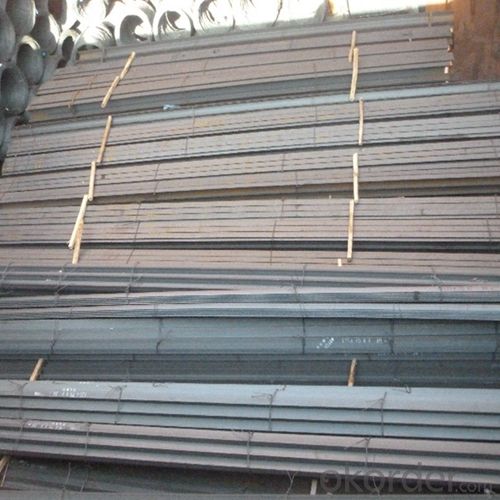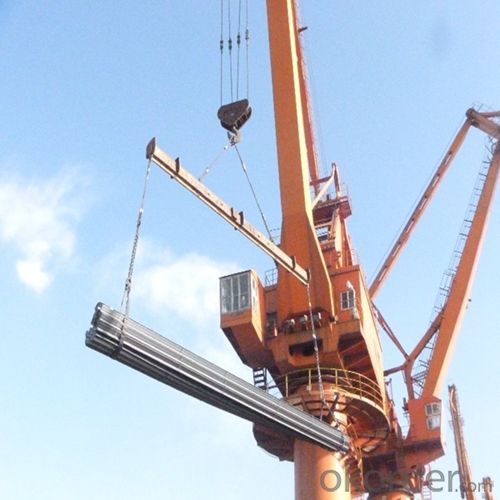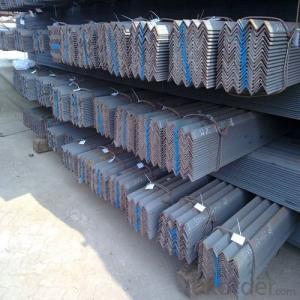Steel Equal Angle Bar for Tower Construction with Small Tolerance
- Loading Port:
- Tianjin
- Payment Terms:
- TT or LC
- Min Order Qty:
- 25 m.t.
- Supply Capability:
- 30000 m.t./month
OKorder Service Pledge
OKorder Financial Service
You Might Also Like
1. Structure of Steel Equal Angle Bar Description:
Steel equal angle bar is a main kind of structure steel and the section is like a letter L. We use steel equal angle bar for tower construction. Steel equal angle bar can be erected as soon as the materials are delivered on site. High strength, stiffness, toughness, and ductile properties are advantages of this kind of steel equal angle bar.
2. Main Features of Steel Equal Angle Bar:
• Strength - Having high strength, stiffness, toughness, and ductile properties, structural steel is one of the most commonly used materials in commercial and industrial building construction.
• Constructability - Steel equal angle Bar can be developed into nearly any shape, which are either bolted or welded together in construction. Structural steel can be erected as soon as the materials are delivered on site, whereas concrete must be cured at least 1–2 weeks after pouring before construction can continue, making steel a schedule-friendly construction material.
• Fire resistance - Steel is inherently a noncombustible material. However, when heated to temperatures seen in a fire scenario, the strength and stiffness of the material is significantly reduced. The steel equal angle bar can be enveloped in sufficient fire-resistant materials, increasing overall cost of steel structure buildings.
3. Steel Equal Angle Bar Images:



4. Steel Equal Angle Bar Specification:
Angle | KG/M | Angle | KG/M | Angle | KG/M | Angle | KG/M |
20X20X3 | 0.889 | 60X60X5 | 4.570 | 90X90X8 | 10.946 | 130X130X12 | 23.600 |
20X20X4 | 1.145 | 60X60X6 | 5.427 | 90X90X9 | 12.220 | 130X130X13 | 25.400 |
25X25X2 | 0.763 | 63X63X4 | 3.907 | 90X90X10 | 13.476 | 130X130X14 | 27.200 |
25X25X3 | 1.124 | 63X63X5 | 4.822 | 90X90X15 | 15.940 | 130X130X16 | 30.900 |
25X25X4 | 1.459 | 63X63X6 | 5.721 | 100X100X6 | 9.366 | 140X140X10 | 21.488 |
30X30X2 | 0.922 | 63X63X8 | 7.469 | 100X100X7 | 10.830 | 140X140X12 | 25.522 |
30X30X3 | 1.373 | 63X63X10 | 9.151 | 100X100X8 | 12.276 | 140X140X14 | 29.490 |
30X30X4 | 1.786 | 70X70X4 | 4.372 | 100X100X10 | 15.120 | 140X140X15 | 31.451 |
36X36X3 | 1.656 | 70X70X5 | 5.397 | 100X100X12 | 17.898 | 140X140X16 | 33.393 |
5. FAQ
We have organized several common questions for our clients,may help you sincerely:
①How about the corrosion of the products?
When the steel equal angle bar in contact with water, can corrode, creating a potentially dangerous structure. Measures must be taken in structural steel construction to prevent any lifetime corrosion. The steel can be painted, providing water resistance. Also, the fire resistance material used to envelope steel is commonly water resistant.
②How to inspect the quality?
We have a professional inspection group which belongs to our company. We resolutely put an end to unqualified products flowing into the market. At the same time, we will provide necessary follow-up service assurance.
We have established the international advanced quality management system,every link from raw material to final product we have strict quality test;We resolutely put an end to unqualified products flowing into the market. At the same time, we will provide necessary follow-up service assurance.③What is the difference between steel angle bar and traditional material?
Steel equal angle bar differs from concrete in its attributed compressive strength as well as tensile strength.
- Q:How do you cut steel angles?
- Steel angles can be cut using various methods such as using a metal-cutting saw, an angle grinder with a cutting disc, or a plasma cutter. It is important to ensure proper safety precautions, use appropriate tools, and follow the manufacturer's instructions for the specific cutting method being used.
- Q:Where does channel steel use more? Where does angle iron use more?
- Hot rolled stainless steel ordinary channel (GB707-88) main use: ordinary channel steel, mainly used for building structures, vehicle manufacturing and other industrial structures, often with the use of i-beam.
- Q:How do steel angles behave under seismic forces?
- Steel angles behave differently under seismic forces depending on their design, size, and connection details. Generally, steel angles are commonly used in seismic-resistant structures due to their ability to dissipate energy and resist lateral forces. Here are some key characteristics of how steel angles behave under seismic forces: 1. Ductility: Steel angles exhibit high ductility, which allows them to undergo large deformations without failure. This property is crucial in seismic design as it allows the structure to absorb and dissipate energy during an earthquake, preventing sudden collapse. 2. Flexibility: Steel angles have the ability to flex and bend under seismic forces, allowing them to absorb energy and reduce the impact on the overall structure. This flexibility helps in distributing the seismic forces throughout the structure, minimizing localized damage. 3. Connection behavior: Proper connection design is crucial to ensure the performance of steel angles under seismic forces. The connections should be designed to allow for rotation and accommodate the expected displacements during an earthquake. Adequate connections prevent the angles from becoming brittle or failing prematurely. 4. Buckling resistance: Steel angles are susceptible to buckling under compression forces. To enhance their buckling resistance, lateral bracing or stiffeners are often used. These elements provide additional support to the angles and help prevent buckling during seismic events. 5. Strength and stiffness: Steel angles have high strength and stiffness, which allows them to resist the lateral forces induced by an earthquake. The strength of steel angles can be enhanced through proper material selection, such as using higher-grade steel with greater yield strength. Overall, steel angles are well-suited for seismic-resistant structures due to their ductility, flexibility, and strength. However, their behavior under seismic forces heavily relies on proper design, connection details, and adherence to seismic codes and standards. It is essential to consult with structural engineers and follow best practices to ensure the optimal performance of steel angles in seismic design.
- Q:What are the considerations for selecting the appropriate steel angle thickness?
- When selecting the appropriate steel angle thickness, there are several considerations to take into account. 1. Structural requirements: The first and most important consideration is the structural requirements of the project. This includes the load-bearing capacity, support requirements, and any specific design codes or standards that need to be followed. The steel angle thickness should be chosen in a way that ensures the structural integrity of the project. 2. Application: The application of the steel angle also plays a significant role in determining the appropriate thickness. Different applications have different demands in terms of strength, durability, and resistance to environmental factors. For example, if the steel angle is intended to be used in a corrosive environment, a thicker thickness may be required to provide better protection against corrosion. 3. Cost-effectiveness: Cost is always an important consideration in any construction project. While thicker steel angles may offer greater strength and stability, they can also be more expensive. It is essential to strike a balance between the required strength and the available budget to ensure cost-effectiveness. 4. Manufacturing and fabrication limitations: The selected steel angle thickness should be within the manufacturing and fabrication capabilities of the manufacturer. It is crucial to consider the availability of the desired thickness and the feasibility of producing the required dimensions. 5. Aesthetic considerations: In some cases, the appearance of the steel angle may be a factor to consider. Thicker angles may have a more substantial and visually appealing look, which can be desirable in certain architectural or design applications. 6. Availability and standard sizes: Availability of steel angles in different thicknesses and standard sizes can also influence the selection process. It is often more convenient and cost-effective to choose a thickness that is readily available in the market. In conclusion, selecting the appropriate steel angle thickness requires careful consideration of structural requirements, application demands, cost-effectiveness, manufacturing limitations, aesthetic preferences, and the availability of standard sizes. By taking all these factors into account, one can make an informed decision that meets the project's needs and ensures the desired level of strength and durability.
- Q:How can steel angles be protected against corrosion?
- Steel angles can be protected against corrosion through various methods such as applying protective coatings like paint or galvanization, using corrosion inhibitors, implementing cathodic protection systems, or selecting stainless steel angles which are inherently resistant to corrosion.
- Q:What are the standard dimensions of steel angles?
- The standard dimensions of steel angles vary depending on the specific type of angle, such as equal or unequal angle. In general, the standard dimensions of steel angles are measured by the length of each leg and the thickness of the material. Equal steel angles typically have equal legs, meaning both sides of the angle are of equal length. The standard dimensions for equal steel angles range from 20mm x 20mm x 3mm to 200mm x 200mm x 24mm. These measurements refer to the length of each leg and the thickness of the angle. Unequal steel angles, on the other hand, have legs of different lengths. The standard dimensions for unequal steel angles range from 40mm x 25mm x 4mm to 200mm x 150mm x 12mm. Again, these measurements indicate the length of each leg and the thickness of the angle. It is important to note that these dimensions are just standard measurements, and custom sizes can also be manufactured based on specific requirements. Additionally, these measurements may vary slightly depending on different steel standards and regional practices.
- Q:What is the typical tolerance for steel angles?
- The typical tolerance for steel angles depends on the specific application and industry standards. However, in general, the industry standard for the tolerance of steel angles is ±1/8 inch or ±3 millimeters. This means that the actual dimensions of the angle can deviate by up to 1/8 inch or 3 millimeters from the specified dimensions. It is important to note that these tolerances may vary for different grades of steel and specific manufacturing processes. Therefore, it is crucial to consult the relevant industry standards or specifications for the specific project to determine the exact tolerance requirements for steel angles in that particular application.
- Q:What is angle flower? Is it the same as angle iron?
- I'm here to tell you that the angle iron is the common name of galvanized steel bar, so the difference between the angle iron and the angle iron is that the surface is made of zinc coating. Angle iron is generally used for electrical installations.
- Q:What are the different types of steel angle profiles?
- There are several different types of steel angle profiles, including equal angle, unequal angle, L-shaped angle, and structural angle. Each profile has its own specific dimensions and uses in various applications.
- Q:What are the alternatives to steel angles in construction?
- There are several alternatives to steel angles in construction that offer different advantages and disadvantages depending on the specific application. 1. Aluminum angles: Aluminum angles are lightweight and corrosion-resistant, making them a popular choice for outdoor construction projects. They are also easily machinable and have good electrical conductivity. However, aluminum angles may not have the same strength and load-bearing capacity as steel angles, making them less suitable for heavy-duty structural applications. 2. Fiberglass angles: Fiberglass angles are lightweight, non-conductive, and highly resistant to corrosion and chemical damage. They are commonly used in industries where exposure to harsh environments, such as water or chemicals, is a concern. However, fiberglass angles may not have the same strength as steel angles and may require additional reinforcement for heavy loads. 3. Carbon fiber angles: Carbon fiber angles are lightweight, high-strength, and have excellent resistance to corrosion. They are commonly used in applications where weight reduction is critical, such as aerospace and automotive industries. However, carbon fiber angles tend to be more expensive than steel angles and may require specialized manufacturing techniques. 4. Wood angles: Wood angles, typically made from hardwood or engineered wood products, are a traditional alternative to steel angles in construction. They are readily available, cost-effective, and easy to work with. Wood angles are often used in residential and light commercial construction projects. However, wood angles may not have the same strength and durability as steel angles and may be more prone to warping, cracking, or rotting over time. It's important to consider the specific requirements of the construction project, including the load-bearing capacity, environmental conditions, and budget, when choosing an alternative to steel angles. Consulting with a structural engineer or construction professional can help determine the most suitable option for each specific scenario.
1. Manufacturer Overview |
|
|---|---|
| Location | |
| Year Established | |
| Annual Output Value | |
| Main Markets | |
| Company Certifications | |
2. Manufacturer Certificates |
|
|---|---|
| a) Certification Name | |
| Range | |
| Reference | |
| Validity Period | |
3. Manufacturer Capability |
|
|---|---|
| a)Trade Capacity | |
| Nearest Port | |
| Export Percentage | |
| No.of Employees in Trade Department | |
| Language Spoken: | |
| b)Factory Information | |
| Factory Size: | |
| No. of Production Lines | |
| Contract Manufacturing | |
| Product Price Range | |
Send your message to us
Steel Equal Angle Bar for Tower Construction with Small Tolerance
- Loading Port:
- Tianjin
- Payment Terms:
- TT or LC
- Min Order Qty:
- 25 m.t.
- Supply Capability:
- 30000 m.t./month
OKorder Service Pledge
OKorder Financial Service
Similar products
New products
Hot products


























